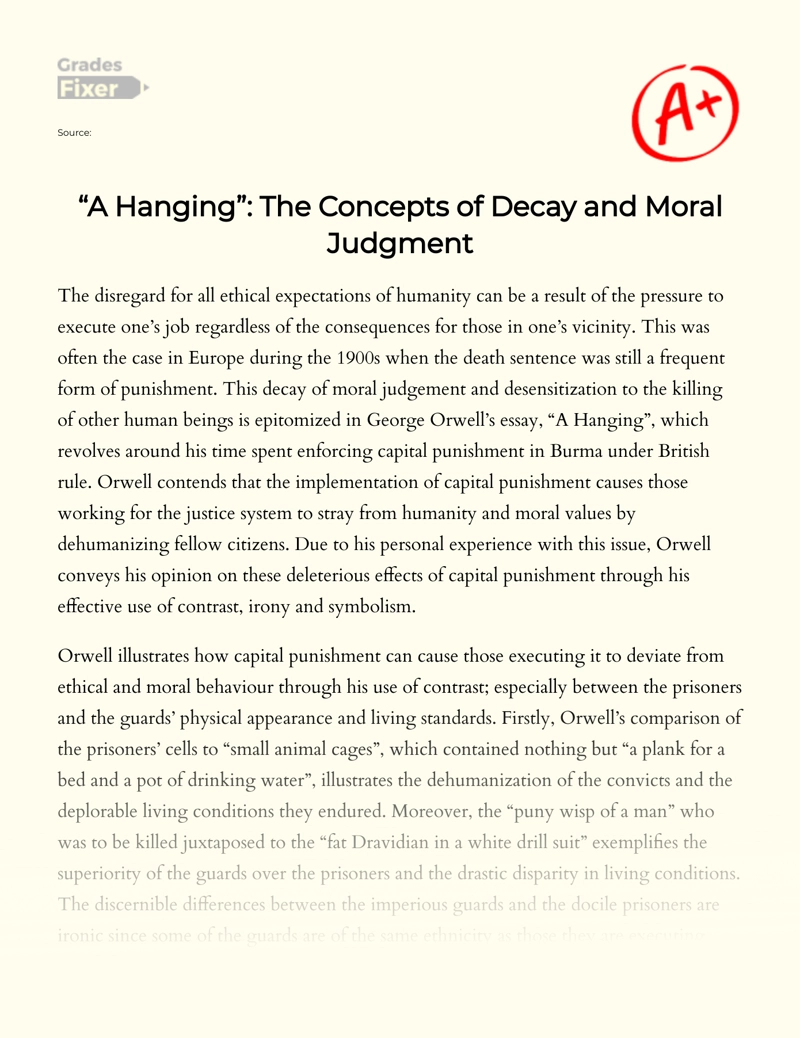

A Summary and Analysis of George Orwell’s ‘A Hanging’
By Dr Oliver Tearle (Loughborough University)
‘A Hanging’ is a short essay by George Orwell. However, to this simple statement we should probably add two caveats. One is the difficulty of categorisation, when Orwell himself described this ‘essay’ as ‘a story’, suggesting it was fiction rather than an account of a real-life event.
The other caveat is about the by-line under which ‘A Hanging’ first appeared. It was one of his earliest published works, and indeed, it didn’t originally appear in print under the name ‘George Orwell’ but under Orwell’s real name, Eric Blair.
Published in Adelphi magazine in 1931, ‘A Hanging’ draws on Orwell’s experiences in imperial Burma in the 1920s, when he worked there as a policeman. Before we offer an analysis of the essay – or ‘story’ – let’s briefly summarise the content of ‘A Hanging’. You can read the essay here .
‘A Hanging’: summary
Orwell describes one morning in Burma when a condemned man was hanged. The superintendent of the jail where the prisoner is being kept is impatient to get the hanging over with because the other prisoners won’t get their breakfast until it has been done.
The head jailor is a man named Francis, a member of the Dravidians (a race of south Asian people found in India and nearby countries), whose speech, including his sibilant rendering of ‘is’ as ‘iss’, Orwell documents in Dickensian fashion.
Orwell focuses on small incidents that occur in the run-up to the hanging: while the prisoner is being led from his cell to the gallows, a stray dog appears and approaches the crowd of men, trying to lick the prisoner’s face. The prisoner seems uninterested in the merry dance that follows, whereby the prison warder and a young jailor try to catch the dog or shoo it away.
As Orwell follows the condemned man to the gallows, he reflects that this was the first time he had reflected on what it means to execute someone in their prime of life, when they are healthy and conscious.
When the prisoner reaches the gallows, he cries out to his god repeatedly, shouting ‘Ram!’ over and over. A bag is placed over his head and he keeps crying out, until the order is given to drop the carry out the execution.
After the hanging, the men, including Orwell, walk back, and the head jailor shares a story of a hanging where the doctor had to pull the prisoner’s legs to ‘ensure decease’. He then tells another story of a prisoner who resisted being removed from his cell before his execution, and six warders had to pull the man out.
The men laugh at this story, and the superintendent offers them all a drink of whisky. They go and drink together, laughing. Orwell’s closing words remind us that the ‘dead man was a hundred yards away.’
‘A Hanging’: analysis
Like another of Orwell’s ‘essays’ which draw upon his experiences in Burma, ‘Shooting an Elephant’ (which we discuss here ), the extent to which ‘A Hanging’ is actually a work of autobiography or non-fiction has been disputed.
Indeed, even Orwell himself said as much, describing it to his friend and housekeeper as ‘only a story’. However, on other occasions he wrote in print that he had indeed seen a man hanged ‘once’: in The Road to Wigan Pier (1937), he remarked, ‘I watched a man hanged once; it seemed to me worse than a thousand murders.’
It is possible that Orwell sought to distance himself from the ‘I’ who narrates the account in ‘A Hanging’ – perhaps because he came to detest his involvement in imperialism – but it’s also perfectly possible that Orwell was using a fictionalised event to represent the common experience of native men being hanged by the imperial class in south Asia.
Whichever interpretation is the accurate one, and perhaps we will never know, there is reason to believe that Orwell was embellishing the account, at the very least. As James Wood points out in his How Fiction Works – the best introduction to how narrative devices work in fiction, in our opinion, and strongly recommended – the moment where the condemned man ‘stepped slightly aside to avoid a puddle on the path’ appears to have been lifted from Tolstoy’s War and Peace .
In Tolstoy’s novel, Wood reminds us, Pierre witnesses a man being executed and observes that, just before death, the condemned man adjusts the blindfold at the back of his head because it’s a little too tight.
It says a great deal about Orwell’s skill as a writer that he seized upon this telling detail – why would a man who is about to lose his life care if his shoes get wet? But then it’s human nature to do so, and is a subtle and realistic reminder that this is a living, breathing human being who is being sent to the gallows, a person just like you and me, and old habits such as avoiding puddles would die hard.
It seems almost comically absurd, but it rings all the more true as a result. Orwell’s long essay on Charles Dickens, which – like his essay on Gulliver’s Travels – shows what a keen eye for literary analysis he had, reveals a surprising affinity between the two writers, in that they both understood how, at moments of extreme mental anguish, small and seemingly inconsequential details become all the more important in revealing human character.
Consider, in this regard, how Dickensian is Orwell’s own description of the tense moment leading up to the execution itself:
The hangman climbed down and stood ready, holding the lever. Minutes seemed to pass. The steady, muffled crying from the prisoner went on and on, ‘Ram! Ram! Ram!’ never faltering for an instant. The superintendent, his head on his chest, was slowly poking the ground with his stick; perhaps he was counting the cries, allowing the prisoner a fixed number – fifty, perhaps, or a hundred.
That repeated ‘perhaps’ is reminiscent of someone trying to keep their mind occupied while they wait for the horrible moment to arrive. It’s also reminiscent, perhaps, of the moment when Fagin, in Oliver Twist , is awaiting the judge’s sentencing which will lead to his hanging:
Not that, all this time, his mind was, for an instant, free from one oppressive overwhelming sense of the grave that opened at his feet; it was ever present to him, but in a vague and general way, and he could not fix his thoughts upon it. Thus, even while he trembled, and turned burning hot at the idea of speedy death, he fell to counting the iron spikes before him, and wondering how the head of one had been broken off, and whether they would mend it, or leave it as it was. Then, he thought of all the horrors of the gallows and the scaffold – and stopped to watch a man sprinkling the floor to cool it – and then went on to think again.
This panicked need to occupy the mind to stop it from fixating on the dreaded theme of death is something Orwell conveys so well, even as bystander rather than condemned man, in ‘A Hanging’.
As with ‘Shooting an Elephant’, where Orwell – or his semi-fictionalised narrator, at least – is beset by a morbid fear of being laughed at by the native Burmese population, laughter plays an important part in ‘A Hanging’, dominating its final ‘scene’.
And indeed, even before this, the essay is filled with moments which are described almost comically, from the head jailor’s hissing voice to the jailors’ failed attempts to get rid of the dog that interrupts their procession to the gallows.
But the laughter at the end of the essay is harder to analyse: is it nervous laughter? The laughter of the imperial overlords and their indifference to the lives of the natives? It is, perhaps, both: signalling the nervousness of those who feel uneasy occupying such a position, and who must take refuge in the collective, and in alcohol, to make such things palatable.
Discover more from Interesting Literature
Subscribe to get the latest posts sent to your email.
Type your email…
1 thought on “A Summary and Analysis of George Orwell’s ‘A Hanging’”
I read that essay before and it was quite a depressing event. Still, I love his writing.
Comments are closed.
Subscribe now to keep reading and get access to the full archive.
Continue reading
A Critical Analysis of George Orwell's 'A Hanging'
BBC/Wikimedia Commons/Public Domain
- An Introduction to Punctuation
- Ph.D., Rhetoric and English, University of Georgia
- M.A., Modern English and American Literature, University of Leicester
- B.A., English, State University of New York
This assignment offers guidelines on how to compose a critical analysis of "A Hanging," a classic narrative essay by George Orwell.
Preparation
Carefully read George Orwell's narrative essay "A Hanging." Then, to test your understanding of the essay, take our multiple-choice reading quiz . (When you're done, be sure to compare your answers with those that follow the quiz.) Finally, re read Orwell's essay, jotting down any thoughts or questions that come to mind.
Composition
Following the guidelines below, compose a soundly supported critical essay of about 500 to 600 words on George Orwell's essay "A Hanging."
First, consider this brief commentary on the purpose of Orwell's essay:
"A Hanging" is not a polemical work. Orwell's essay is intended to express by example "what it means to destroy a healthy, conscious man." The reader never finds out what crime was committed by the condemned man, and the narrative isn't primarily concerned with providing an abstract argument regarding the death penalty. Instead, through action, description , and dialogue , Orwell focuses on a single event that illustrates "the mystery, the unspeakable wrongness, of cutting a life short when it is in full tide."
Now, with this observation in mind (an observation that you should feel free to either agree with or disagree with), identify, illustrate, and discuss the key elements in Orwell's essay that contribute to its dominant theme .
Keep in mind that you're composing your critical analysis for someone who has already read "A Hanging." That means you don't need to summarize the essay. Be sure, however, to support all your observations with specific references to Orwell's text. As a general rule, keep quotations brief. Never drop a quotation into your paper without commenting on the significance of that quotation.
To develop material for your body paragraphs , draw on your reading notes and on points suggested by the multiple-choice quiz questions. Consider, in particular, the importance of point of view , setting , and the roles served by particular characters (or character types).
Revision and Editing
After completing a first or second draft , rewrite your composition. Be sure to read your work aloud when you revise , edit , and proofread . You may hear problems in your writing that you can't see.
- Reading Quiz on "A Hanging" by George Orwell
- Plain Style in Prose
- Definition and Examples of Formal Essays
- What is a Familiar Essay in Composition?
- Hear and Here
- Supporting Detail in Composition and Speech
- Tetracolon Climax (Rhetoric and Sentence Styles)
- Sentence Building with Appositives
- What Is Newspeak?
- What Is Colloquial Style or Language?
- Critical Analysis in Composition
- Definition and Examples of Appositives in English
- On Laziness by Christopher Morley
- Changing Verbs From Passive to Active
- 100 Major Works of Modern Creative Nonfiction
“A Hanging” Essay by George Orwell Essay
- To find inspiration for your paper and overcome writer’s block
- As a source of information (ensure proper referencing)
- As a template for you assignment
Features of Writing
Orwell’s attitude, personal reflection.
George Orwell’s works are a vivid example of acute social dystopia and pressing problems associated with interaction among people. Many of his major works became great literary masterpieces, but in addition to novels, the author also wrote small essays, where he also raised topical issues. As an object of analysis, his work “A Hanging” in the genre of a first-person narrative short story will be considered. When an employee of the British Imperial Police in the 1920s, Orwell witnessed many controversial and even frightening events and incidents, and one of them formed the basis of this essay. Undisguised tension and hyperrealism are the characteristic features of “A Hanging,” and the author’s inner experiences, along with his emotional assessment of what happens, allow conveying a wide range of feelings that affect the reader.
One of the remarkable features of this work is the style of presentation. Orwell (2000) resorts to a first-person narrative technique, which allows readers to immerse themselves in the story as deeply as possible and evaluate it through the eyes of the author himself. Many sentences are short and non-exhaustive to create additional intrigue and increase tension. Orwell (2000) resorts to various literary techniques, in particular, comparisons and subtexts, to emphasize some ideas. For instance, the author constantly compares the weather of that day with various everyday aspects in order to describe the situation in detail (Orwell, 2000).
The dog that appears on the path of the procession may be the personification of a thirst for life, which the prisoner does not show but keeps in himself (Orwell, 2000). All these techniques help to better reflect the tension of the situation and convey the observer’s emotions.
The emphasis on details is an additional tool that allows focusing readers’ attention on specific nuances of the narrative. The position of the prisoner’s hands, the location of the guards, the executioner’s appearance, and other unique elements of the story that Orwell (2000) presents help create an atmosphere of immersion. As a result, despite a small volume of this essay, the narrative is detailed and covers a short time period with the greatest possible accuracy.
When evaluating the author’s attitude to the story, readers may notice how ambiguous the narrator’s feelings are. He does not hide anxiety, and when the prisoner who is constantly repeating the name of his God is brought to the gallows, a climax sets in, and the emotions of Orwell (2000) are sharpened. It is felt in the narrative that he takes part in this entire procedure reluctantly and has no choice but to accompany the prisoner to the place of his execution. The remarks regarding convict’s stepping over a puddle in the yard prove that Orwell (2000) is concerned about the injustice of the world and the laws that take away a physically healthy person’s life. As a result, before the execution, mixed feelings of anxiety and hopelessness are traced in the author’s narrative.
After the execution, a radical change in the author’s mood reflects his relief and desire to forget about the tense situation. Both Orwell (2000) and his colleagues laugh out loud and discuss extraneous topics, and this abrupt shift in the tone of the story indicates that the author does not want to recall recent events. Accordingly, one can note that any execution is a test for the narrator who is ready to forget this experience immediately.
“A Hanging” is one of the successful works written by Orwell (2000), and the brevity of this story cannot be considered a flaw. The author conveys a wide range of feelings and captivates readers with a tense plot, which, at the same time, reflects a short period of the prisoner’s transfer to the place of execution (Orwell, 2000). The applied literary techniques provide a clear picture of the situation and help understand the experiences that may accompany such a procedure.
Although there is no clearly defined introduction or conclusion in the work, the essay allows readers to understand the situation quickly, and additional details are not needed in order to feel the tension. The author’s attitude is obvious, and it is noticeable that Orwell (2000), who performs his duty, is not ready to accept the reality in which a person is deprived of life by force. Therefore, despite the fact that this essay does not apply to the dystopian genre, vivid details highlight social vices and reflect how controversial laws may be.
The story of “A Hanging” is a vivid example of Orwell’s work, and the realism of the essay makes it possible to feel the whole depth of emotions experienced by the author. The features of writing allow plunge into the atmosphere of the narrative and perceive all the events described as clearly as possible. The author’s attitude is also obvious because fear, misunderstanding, and subsequent relief are transmitted openly. This essay does not belong to the dystopian genre, but it also addresses acute social problems and raises the essential issues of human rights and freedoms.
Orwell, G. (2000). Essays . London, UK: Penguin Books.
- Aesthetics in Wilde's "The Picture of Dorian Gray"
- The Power of Gaze in Bronte’s “Wuthering Heights”
- "Shooting an Elephant" by G. Orwell Review
- Dystopian Fiction for Young Readers
- Events in the 1984 by George Orwell
- Fanaticism in “The Prophet’s Hair” by Rushdie
- Responsibility in “Frankenstein” by Mary Shelly
- Hamlet Writing Assignment: “Something Is Rotten in the State of Denmark”
- Victorian Era in "Lady Audley’s Secret" by Mary Braddon
- George Orwell's "Shooting an Elephant" Short Story
- Chicago (A-D)
- Chicago (N-B)
IvyPanda. (2021, June 30). “A Hanging” Essay by George Orwell. https://ivypanda.com/essays/a-hanging-essay-by-george-orwell/
"“A Hanging” Essay by George Orwell." IvyPanda , 30 June 2021, ivypanda.com/essays/a-hanging-essay-by-george-orwell/.
IvyPanda . (2021) '“A Hanging” Essay by George Orwell'. 30 June.
IvyPanda . 2021. "“A Hanging” Essay by George Orwell." June 30, 2021. https://ivypanda.com/essays/a-hanging-essay-by-george-orwell/.
1. IvyPanda . "“A Hanging” Essay by George Orwell." June 30, 2021. https://ivypanda.com/essays/a-hanging-essay-by-george-orwell/.
Bibliography
IvyPanda . "“A Hanging” Essay by George Orwell." June 30, 2021. https://ivypanda.com/essays/a-hanging-essay-by-george-orwell/.
Academia.edu no longer supports Internet Explorer.
To browse Academia.edu and the wider internet faster and more securely, please take a few seconds to upgrade your browser .
Enter the email address you signed up with and we'll email you a reset link.
- We're Hiring!
- Help Center

A Hanging": George Orwell's Unheralded Literary Breakthrough

Related Papers
Nadia Prescott
Papers of The Bibliographical Society of Canada
Peter Stansky
George Orwell, the Search for a Voice
Lynette Hunter
Darcy Moore
The HSC syllabus may change but some writers persist. Shakespeare retains his status, Austen stays and Dickens re-enters but only one writer other than Shakespeare, George Orwell, has three entries, with 1984 in the Common Module Texts and Human Experience, and two essays in the Craft of Writing, one for Advanced and one for Standard students. His status is assured for good reasons. The following article offers an overview of Orwell’s context to support you in teaching any Orwell text.
Modern Intellectual History
Anna Vaninskaya
The Orwell centenary of 2003 has come and gone, but the pace of academic publications that usually accompany such biographical milestones has not slackened. The Cambridge Companion to George Orwell was released in summer 2007, John Rodden's Every Intellectual's Big ...
American Scholar
Morris Dickstein
John S Partington
George Orwell Studies vol 1
Douglas Kerr
This essay is not so much a study of 'influence' as an attempt to observe some of the ways his reading of Conrad helped to clarify for Orwell the writer he himself needed to become. His response to Conrad as a writer about Oriental places and people, and as a political novelist, has an important bearing on his own practice, and through his reading of Conrad we can watch him struggling with questions of theme, attitude, and technique that confronted his own creative work. Finally, this essay looks at the case of the haunting presence of Conrad's Lord Jim in the working notes for A Smoking-Room Story, the novel Orwell was planning in 1949, the last year of his life.
George Orwell Studies
George Orwell continues to have an extraordinary influence on how the English view England, writes Darcy Moore in his review of an important contemporary work of history. The English and Their History: The First Thirteen Centuries (2014) by Robert Tombs has deservingly been described as a ‘triumph’, ’magisterial’ and ‘astonishing’ by reviewers. The historian has been praised for being ‘shrewdly detached’ and writing with ‘precision and candour’. There is plenty of support for the view this will be ‘the standard history for years’ (see, for instance, Davenport-Hines 2014; Hitchens 2015, Mullin 2015).
Loading Preview
Sorry, preview is currently unavailable. You can download the paper by clicking the button above.
RELATED PAPERS
Monthly Review
Jonah Raskin
Journal of British Studies
Daniel Ritschel
École Noire/AcademicOnDemand
Ralph Pordzik
Behavioral Disorders
robert zabel
Disputing the Deluge
Darko Suvin
The Cambridge Companion to Orwell, edited by John Rodden
Neil Mclaughlin
Hamza Touzani
Journal of Arts and Social Sciences [JASS]
Neil McBeath
Journal of World-Systems Research
Brendan McQuade
Robert Osenenko
Mariam Elgohary
Internet Encyclopedia of Philosophy
Alberto Lázaro
Andrea Porcheddu
James Humphrey
AFM Zakaria
Critical Insights: 1984
Erik Jaccard
Gaziantep University Journal of Social Sciences
Özlem Özmen Akdoğan
EDITOR: Erwin Marquit (physics, Univ. of …
Philip Bounds
Robert McParland
- We're Hiring!
- Help Center
- Find new research papers in:
- Health Sciences
- Earth Sciences
- Cognitive Science
- Mathematics
- Computer Science
- Academia ©2024
Pardon Our Interruption
As you were browsing something about your browser made us think you were a bot. There are a few reasons this might happen:
- You've disabled JavaScript in your web browser.
- You're a power user moving through this website with super-human speed.
- You've disabled cookies in your web browser.
- A third-party browser plugin, such as Ghostery or NoScript, is preventing JavaScript from running. Additional information is available in this support article .
To regain access, please make sure that cookies and JavaScript are enabled before reloading the page.

26 pages • 52 minutes read
A modern alternative to SparkNotes and CliffsNotes, SuperSummary offers high-quality Study Guides with detailed chapter summaries and analysis of major themes, characters, and more.
Essay Analysis
Key Figures
Symbols & Motifs
Literary Devices
Important Quotes
Essay Topics
Discussion Questions
The Inhumanity of the Death Penalty
“A Hanging” is initially marked by the specificity and unfamiliarity of its remote setting , but the narrator’s incursions broaden the text into an explicit and more universal reflection on the wrongness of capital punishment.
Discussions of the death penalty often focus on the fittingness of the punishment to the crime, adopting or rejecting common arguments that tie execution to particularly violent acts. George Orwell precludes any such reflections in this story by providing no information as to why the prisoner was condemned. His focus is exclusively on the horror of deliberately curtailing any human life—“the mystery, the unspeakable wrongness, of cutting a life short when it is in full tide” (Paragraph 10). He emphasizes the irrepressible life force of the prisoner, who instinctively acts to remain clean and preserve his dignity even when his death is just minutes away.
The members of the execution party implicitly justify their actions by creating a barrier between themselves and the prisoner. The dog’s behavior betrays the artificiality of these distinctions, prompting the narrator to recognize his unity with the condemned man:


Related Titles
By George Orwell

Animal Farm

Burmese Days

Coming Up for Air

Down and Out in Paris and London

Homage To Catalonia
Keep the Aspidistra Flying

Politics and the English Language
Shooting an Elephant

Such, Such Were the Joys

The Road to Wigan Pier

Why I Write

Featured Collections
Asian History
View Collection
Books on Justice & Injustice
Colonialism & Postcolonialism
European History
Mortality & Death
Politics & Government
Home — Essay Samples — Literature — A Hanging — “A Hanging”: The Concepts of Decay and Moral Judgment
"A Hanging": The Concepts of Decay and Moral Judgment
- Categories: A Hanging George Orwell
About this sample

Words: 1092 |
Published: Jul 2, 2018
Words: 1092 | Pages: 2 | 6 min read

Cite this Essay
Let us write you an essay from scratch
- 450+ experts on 30 subjects ready to help
- Custom essay delivered in as few as 3 hours
Get high-quality help

Dr Jacklynne
Verified writer
- Expert in: Literature

+ 120 experts online
By clicking “Check Writers’ Offers”, you agree to our terms of service and privacy policy . We’ll occasionally send you promo and account related email
No need to pay just yet!
Related Essays
3 pages / 1362 words
2 pages / 1022 words
3.5 pages / 1498 words
2.5 pages / 1035 words
Remember! This is just a sample.
You can get your custom paper by one of our expert writers.
121 writers online

Still can’t find what you need?
Browse our vast selection of original essay samples, each expertly formatted and styled
“A Hanging” is a famous essay written by George Orwell. It is set in Burma in 1931 and recalls Orwell’s time spent as an officer in the British Imperial Police in the 1920’s. Orwell recounts in the first-person narrative the [...]
The disregard for all ethical expectations of humanity can be a result of the pressure to execute one’s job regardless of the consequences for those in one’s vicinity. This was often the case in Europe during the 1900s when the [...]
“I had never realized what it means to destroy a healthy, conscious man.” In his essay A Hanging, George Orwell reveals his experience watching a hanging, as an imperial police in Burma. With these experiences, Orwell writes his [...]
Much of Charles Dickens' representation of morality in his most famous of Christmas stories, A Christmas Carol, is derived from "the wisdom of our ancestors." (1) From the beginning of his narrative Dickens explains his usage of [...]
The title year of George Orwell's most famous novel is nineteen years past, but the dystopian vision it draws has retained its ability to grip readers with a haunting sense of foreboding about the future. At the heart of many of [...]
Like Christmas morning itself - when each present represents a discrete mystery, separate from the last - the Christmas Carol is divided into a set of episodes. The book's chapters are episodic, with the duration of each spirit [...]
Related Topics
By clicking “Send”, you agree to our Terms of service and Privacy statement . We will occasionally send you account related emails.
Where do you want us to send this sample?
By clicking “Continue”, you agree to our terms of service and privacy policy.
Be careful. This essay is not unique
This essay was donated by a student and is likely to have been used and submitted before
Download this Sample
Free samples may contain mistakes and not unique parts
Sorry, we could not paraphrase this essay. Our professional writers can rewrite it and get you a unique paper.
Please check your inbox.
We can write you a custom essay that will follow your exact instructions and meet the deadlines. Let's fix your grades together!
Get Your Personalized Essay in 3 Hours or Less!
We use cookies to personalyze your web-site experience. By continuing we’ll assume you board with our cookie policy .
- Instructions Followed To The Letter
- Deadlines Met At Every Stage
- Unique And Plagiarism Free
- About George Orwell
- Partners and Sponsors
- Accessibility
- Upcoming events
- The Orwell Festival
- The Orwell Memorial Lectures
- Books by Orwell
Essays and other works
- Encountering Orwell
- Orwell Live
- About the prizes
- Reporting Homelessness
- Previous winners
- Orwell Fellows
- Finalists 2024
- Introduction
- Enter the Prize
- Terms and Conditions
- Volunteering
- About Feedback
- Responding to Feedback
- Start your journey
- Inspiration
- Find Your Form
- Start Writing
- Reading Recommendations
- Previous themes
- Our offer for teachers
- Lesson Plans
- Events and Workshops
- Orwell in the Classroom
- GCSE Practice Papers
- The Orwell Youth Fellows
- Paisley Workshops
The Orwell Foundation
- The Orwell Prizes
- The Orwell Youth Prize
- The Orwell Council
The Orwell Foundation is delighted to make available a selection of essays, articles, sketches, reviews and scripts written by Orwell.
This material remains under copyright in some jurisdictions, including the US, and is reproduced here with the kind permission of the Orwell Estate . All queries regarding rights should be addressed to the Estate’s representatives at A. M. Heath literary agency.
The Orwell Foundation is an independent charity – please consider making a donation to help us maintain these resources for readers everywhere.
Sketches For Burmese Days
- 1. John Flory – My Epitaph
- 2. Extract, Preliminary to Autobiography
- 3. Extract, the Autobiography of John Flory
- 4. An Incident in Rangoon
- 5. Extract, A Rebuke to the Author, John Flory
Essays and articles
- A Day in the Life of a Tramp ( Le Progrès Civique , 1929)
- A Hanging ( The Adelphi , 1931)
- A Nice Cup of Tea ( Evening Standard , 1946)
- Antisemitism in Britain ( Contemporary Jewish Record , 1945)
- Arthur Koestler (written 1944)
- British Cookery (unpublished, 1946)
- Can Socialists be Happy? (as John Freeman, Tribune , 1943)
- Common Lodging Houses ( New Statesman , 3 September 1932)
- Confessions of a Book Reviewer ( Tribune , 1946)
- “For what am I fighting?” ( New Statesman , 4 January 1941)
- Freedom and Happiness – Review of We by Yevgeny Zamyatin ( Tribune , 1946)
- Freedom of the Park ( Tribune , 1945)
- Future of a Ruined Germany ( The Observer , 1945)
- Good Bad Books ( Tribune , 1945)
- In Defence of English Cooking ( Evening Standard , 1945)
- In Front of Your Nose ( Tribune , 1946)
- Just Junk – But Who Could Resist It? ( Evening Standard , 1946)
- My Country Right or Left ( Folios of New Writing , 1940)
- Nonsense Poetry ( Tribune , 1945)
- Notes on Nationalism ( Polemic , October 1945)
- Pleasure Spots ( Tribune , January 1946)
- Poetry and the microphone ( The New Saxon Pamphlet , 1945)
- Politics and the English Language ( Horizon , 1946)
- Politics vs. Literature: An examination of Gulliver’s Travels ( Polemic , 1946)
- Reflections on Gandhi ( Partisan Review , 1949)
- Rudyard Kipling ( Horizon , 1942)
- Second Thoughts on James Burnham ( Polemic , 1946)
- Shooting an Elephant ( New Writing , 1936)
- Some Thoughts on the Common Toad ( Tribune , 1946)
- Spilling the Spanish Beans ( New English Weekly , 29 July and 2 September 1937)
- The Art of Donald McGill ( Horizon , 1941)
- The Moon Under Water ( Evening Standard , 1946)
- The Prevention of Literature ( Polemic , 1946)
- The Proletarian Writer (BBC Home Service and The Listener , 1940)
- The Spike ( Adelphi , 1931)
- The Sporting Spirit ( Tribune , 1945)
- Why I Write ( Gangrel , 1946)
- You and the Atom Bomb ( Tribune , 1945)
Reviews by Orwell
- Anonymous Review of Burmese Interlude by C. V. Warren ( The Listener , 1938)
- Anonymous Review of Trials in Burma by Maurice Collis ( The Listener , 1938)
- Review of The Pub and the People by Mass-Observation ( The Listener , 1943)
Letters and other material
- BBC Archive: George Orwell
- Free will (a one act drama, written 1920)
- George Orwell to Steven Runciman (August 1920)
- George Orwell to Victor Gollancz (9 May 1937)
- George Orwell to Frederic Warburg (22 October 1948, Letters of Note)
- ‘Three parties that mattered’: extract from Homage to Catalonia (1938)
- Voice – a magazine programme , episode 6 (BBC Indian Service, 1942)
- Your Questions Answered: Wigan Pier (BBC Overseas Service)
- The Freedom of the Press: proposed preface to Animal Farm (1945, first published 1972)
- Preface to the Ukrainian edition of Animal Farm (March 1947)
External links are being provided for informational purposes only; they do not constitute an endorsement or an approval by The Orwell Foundation of any of the products, services or opinions of the corporation or organisation or individual. The Foundation bears no responsibility for the accuracy, legality or content of the external site or for that of subsequent links. Contact the external site for answers to questions regarding its content.
We use cookies. By browsing our site you agree to our use of cookies. Accept

COMMENTS
By Dr Oliver Tearle (Loughborough University) 'A Hanging' is a short essay by George Orwell. However, to this simple statement we should probably add two caveats. One is the difficulty of categorisation, when Orwell himself described this 'essay' as 'a story', suggesting it was fiction rather than an account of a real-life event.
A Hanging. George Orwell: Burmese Days. The Orwell Foundation is an independent charity. We rely on the generosity of donors, Friends and Patrons to maintain these free resources. It was in Burma, a sodden morning of the rains. A sickly light, like yellow tinfoil, was slanting over the high walls into the jail yard.
Following the guidelines below, compose a soundly supported critical essay of about 500 to 600 words on George Orwell's essay "A Hanging." First, consider this brief commentary on the purpose of Orwell's essay: "A Hanging" is not a polemical work. Orwell's essay is intended to express by example "what it means to destroy a healthy, conscious man."
A Hanging (1931) is a short essay written by George Orwell, first published (under his real name) in August 1931 in the John Middleton Murry's British literary magazine The Adelphi [1] and then reprinted in 1946 in the British literary magazine The New Savoy.Set in Burma, where Orwell (under his real name of Eric Arthur Blair) had served in the British Imperial Police from 1922 to 1927, it ...
Published: Aug 6, 2021. In the essay entitled, "A Hanging," the author, George Orwell, writes of a Hindu man preparing to be hanged in a Burmese prison by the warders. Orwell, who himself was part of the warders, had to witness the dreadful hanging and later wrote this descriptive essay on what he had to endure on that particular day.
"A Hanging" •"A Hanging"is a reflectionon one of the many judicial executions witnessed by Orwell in his official capacity as a chief of justice. •Orwell's detailed observations of the prisoner and the events leading up to his eventual death illuminate the banal reality of death and highlight his strong anti-capital
"A Hanging" is an essay written by the English novelist, journalist, essayist, and critic George Orwell (1903-50). It was first published in The Adelphi, a British literary magazine, in 1931.Orwell gained widespread acclaim for his most famous novels, Animal Farm (1945) and Nineteen Eighty-Four (1949). His essays and journalism, like his fiction, explore political themes, societal issues ...
A Hanging (annotated) Part of the British Empire - now known as Myanmar. Orwell worked here as. Rain has negative connotations. "sodden" has connotations of discomfort - could reflect prisoners' feelings. "sickly" has connotations of poor health - reflects prisoners. Simile highlights the glinting sun and the off-colour sky - suggests ...
5.0 (2 reviews) T: "A Hanging" (1931) A: George Orwell. R: Encourages the reader to consider the morality of the death penalty and whether it should be a means of punishment. This arouses feelings of anger and disgust within the reader due to the inhumane and callous nature of capital punishment. T: In the short essay Orwell recounts his ...
Published: Jan 15, 2019. "A Hanging" is a famous essay written by George Orwell. It is set in Burma in 1931 and recalls Orwell's time spent as an officer in the British Imperial Police in the 1920's. Orwell recounts in the first-person narrative the execution of a Hindu prisoner which evokes a powerful epiphany in him.
for this Critical Essay. Question 9 Choose a non-fiction text which made you consider your views about a social or political or ethical issue. Explain what the issue is and how the writer uses language effectively to engage you. The candidate has chosen, as a non-fiction text, the essay 'A Hanging' by George Orwell.
In "A Hanging," George Orwell uses a single event in colonial Burma to critique the death penalty and the corrupt tyranny of empire. Whether "A Hanging" should be considered fiction or autobiography is not entirely clear. As a member of the Imperial Police in Burma, Orwell would likely have witnessed hangings, although he is known to have told a friend that "A Hanging" was "just ...
Key elements in George Orwell's "A Hanging" include the theme of the inhumanity of capital punishment, vividly illustrated through the narrator's internal conflict and the casual cruelty of the ...
The story of "A Hanging" is a vivid example of Orwell's work, and the realism of the essay makes it possible to feel the whole depth of emotions experienced by the author. The features of writing allow plunge into the atmosphere of the narrative and perceive all the events described as clearly as possible. The author's attitude is also ...
His famous essay, "Looking Back on the Spanish Civil War," ends with a poem featuring that image and it is also used as the title of George Woodcock's much-admired book, The Crystal Spirit: A Study of George Orwell (1966). In "A Hanging," England's prose laureate—The Crystal Spirit—is already visible on the horizon.
Introduction. 'A Hanging' by George Orwell is a short, moving, biographical essay that takes us through the key incidents and events that take place of a man who has been convicted of a crime that we do not know about. Orwell writes in a way that makes us the reader re consider wrongs and rights of capital punishment.
A George Orwell's " A Hanging " is a thought provoking essay where (refer to task). Orwell portrays his emotions towards the horrifying events that took place: from the ruthless hanging, the appalling inhumane treatment of the prisoners and his moment of realisation of the wrongness of the situation - whilst stationed in Burma in the 1920s.
He and we were a party of men walking together, seeing, hearing, feeling, understanding the same world; and in two minutes, with a sudden snap, one of us would be gone—one mind less, one world less (Paragraph 10). Thanks for exploring this SuperSummary Study Guide of "A Hanging" by George Orwell. A modern alternative to SparkNotes and ...
In "A Hanging," why does Orwell describe prisoners' cells as "animal cages" and the handling of prisoners like "handling a fish"? What does the dog symbolize in George Orwell's essay "A Hanging"?
This was often the case in Europe during the 1900s when the death sentence was still a frequent form of punishment. This decay of moral judgement and desensitization to the killing of other human beings is epitomized in George Orwell's essay, "A Hanging", which revolves around his time spent enforcing capital punishment in Burma under ...
The main theme in George Orwell's short story, "A Hanging", is capital punishment. Through this essay-like story, the author argues against capital punishment, which he considers morally wrong, regardless of the crime the convict committed. This is why the author focuses on the process of the execution and does not give any details as to ...
critical essay - 'A Hanging'. 'A Hanging' by George Orwell is a non fictional story. Orwell spent his life living and working as a police officer in Burma. In the story orwell uses lots of different techniques and effective language to show how inhumane and cruel capital punishment is. For example he uses symbolism through a dog and a puddle.
A hanging critical essay. Introduction. Many non fictional texts provoke an emotional response in the reader. This is evident in George Orwell's anti colonialism essay 'A hanging'. In the essay Orwell presents the journey of a prisoner who is destined to be hanged. He describes the environment, the prisoner himself, his death and how Orwells ...
Essays and articles. A Day in the Life of a Tramp (Le Progrès Civique, 1929) A Hanging (The Adelphi, 1931) A Nice Cup of Tea (Evening Standard, 1946) Antisemitism in Britain (Contemporary Jewish Record, 1945) ... BBC Archive: George Orwell; Free will (a one act drama, written 1920) George Orwell to Steven Runciman (August 1920) ...